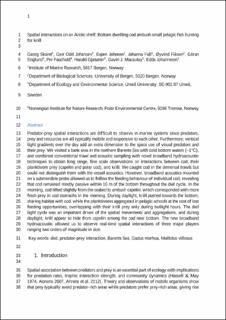| dc.description.abstract | Predator-prey spatial interactions are essential to understand ecosystem processes like predation rates and trophic interaction strength. In marine systems, such spatial interactions are highly dynamic and difficult to observe, as predators, prey and resources are mobile and responsive to each other, and also since shifting vertical light gradients strongly affect the space use of visual predators and their prey. We visited a bank area in the northern Barents Sea with cold bottom waters (~1°C), and combined conventional trawl and acoustic sampling with broadband hydroacoustics to obtain long-range, fine-scale observations of interactions between cod, their planktivore prey (capelin and polar cod) and krill. We caught cod in demersal trawl hauls but could not detect them with the vessel acoustics. However, broadband acoustics mounted on a submersible probe allowed us to track individual cod, revealing that they remained mostly within 10 m of the bottom throughout the diel cycle. In the morning, cod lifted slightly from the seabed indicating feeding activity, which corresponded with more fresh prey in cod stomachs in the morning. During daylight, krill pushed towards the bottom, sharing habitat with cod, while the planktivores aggregated in pelagic schools at the cost of lost feeding opportunities, overlapping with their krill prey only during twilight hours. The diel light cycle was an important driver of the spatial movements and aggregations, and krill appear to hide from capelin among the cod near bottom, while cod take advantage of descending pelagic fish after dawn to feed with a minimum of effort. | en_US |
